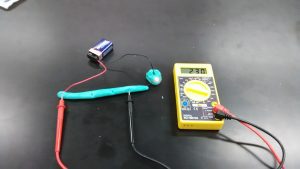Organic Circuits
Objectives
- Simulate neural signals passing along an axon
- Model demyelination to show how signals can be lost along an axon
- Measure the resistivity of a simulated neural fiber
Resources
- Conductive modeling compound (i.e. Play-Doh)
- Non-conductive modeling clay
- 9-volt battery with battery clip
- Multimeter
- LED
- Ruler
Background
The physics of electricity and circuits is utilized in biology. Neurons, for example, use electro-chemical signals to communicate with other neurons, muscles, and endocrine cells. Electrical signals enter a cell body via the dendrites and become attenuated as they cross the cell body. The cell body acts as a switch; if the signal is strong enough when it reaches the axon hillock – the point where the axon protrudes from the cell body – a signal is sent along the axon. Axons act as the primary transmission lines of the nervous system and can be a few millimeters up to a meter or more.
In the human body, many axons are covered with a fatty substance called myelin. This structure aids in sending signals by insulating the axon from the surrounding environment. The signal is boosted along the axon at the nodes of Ranvier, providing the signal is above a certain threshold. This mechanism allows signals to be transmitted long distances along axons.
The resistivity of a material such as cytoplasm describes how much it resists electricity flowing through it. The resistance per unit length of a material with resistivity \rho and cross-sectional area A is given by \rho=A\frac{R}{L}
Building Organic Circuits
The conductive clay you will use in this experiment has more resistance than a metal wire, but still carries current well. A simple circuit can be formed as shown by connecting the terminals of a battery to two different conductive clay blobs, then connecting the blobs with the LED. Note that current can only flow in one direction through the LED – the short terminal should be connected to the blob with the negative (black) battery wire).
The non-conductive clay acts as an insulator. It is a weak conductor and thus blocks most current. A thick layer of it can block current from shorting from one blob to the other, as shown below. However, if the layer becomes too thin, current will travel between the blobs instead and will not reach the LED.
A long strand of conductive clay can act like a wire, carrying a signal current long distances to light up an LED. The resistance of the wire, and thus the voltage drop across it, will depend on its thickness and length.


